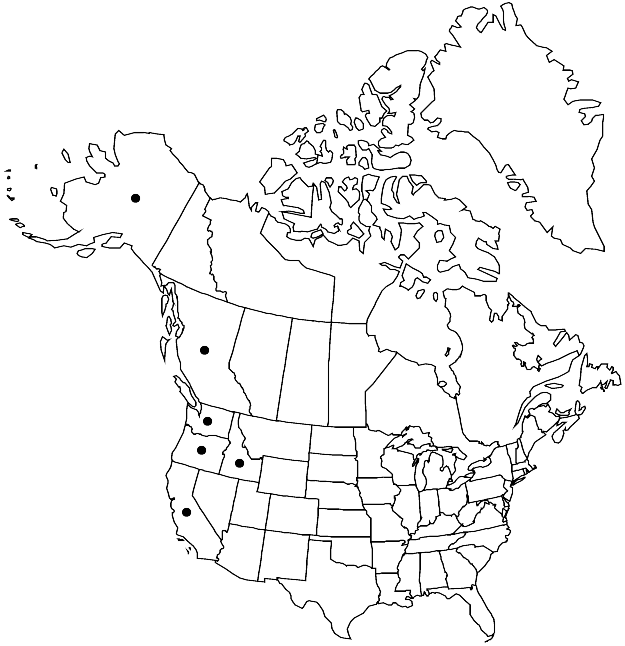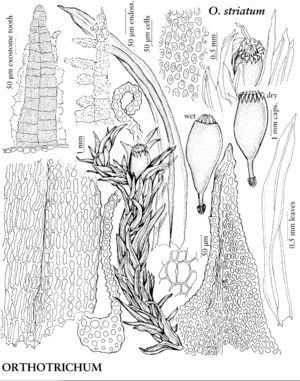Difference between revisions of "Orthotrichum striatum"
Sp. Musc. Frond., 163. 1801.
FNA>Volume Importer |
FNA>Volume Importer |
||
| Line 32: | Line 32: | ||
|elevation=low to moderate elevations (10- 1000 m) | |elevation=low to moderate elevations (10- 1000 m) | ||
|distribution=B.C.;Alaska;Calif.;Idaho;Oreg.;Wash.;Europe;Asia (India in Kashmir);n Africa. | |distribution=B.C.;Alaska;Calif.;Idaho;Oreg.;Wash.;Europe;Asia (India in Kashmir);n Africa. | ||
| − | |discussion=<p>Orthotrichum striatum is distinguished from its closest relatives, O. lyellii, O. pycnophyllum, and O. speciosum, by its ovate, smooth capsules, which are immersed even when dry. The exostome of O. striatum consists of 16 recurved teeth, and the endostome of 16 erose segments. In the flora area, O. striatum is restricted to the Pacific Northwest.</p> | + | |discussion=<p><i>Orthotrichum striatum</i> is distinguished from its closest relatives, <i>O. lyellii</i>, <i>O. pycnophyllum</i>, and <i>O. speciosum</i>, by its ovate, smooth capsules, which are immersed even when dry. The exostome of <i>O. striatum</i> consists of 16 recurved teeth, and the endostome of 16 erose segments. In the flora area, <i>O. striatum</i> is restricted to the Pacific Northwest.</p> |
|tables= | |tables= | ||
|references= | |references= | ||
| Line 55: | Line 55: | ||
|publication year=1801 | |publication year=1801 | ||
|special status=Selected by author to be illustrated | |special status=Selected by author to be illustrated | ||
| − | |source xml=https://jpend@bitbucket.org/aafc-mbb/fna-data-curation.git/src/ | + | |source xml=https://jpend@bitbucket.org/aafc-mbb/fna-data-curation.git/src/8f726806613d60c220dc4493de13607dd3150896/coarse_grained_fna_xml/V28/V28_104.xml |
|genus=Orthotrichum | |genus=Orthotrichum | ||
|species=Orthotrichum striatum | |species=Orthotrichum striatum | ||
Revision as of 17:03, 18 September 2019
Plants 1–6 cm. Stem leaves loosely erect, flexuose when dry, lanceolate, 3–4 mm; margins apparently revolute to near apex, entire; apex narrowly acute to acuminate; basal laminal cells elongate, walls thick, nodose; distal cells 7–9 µm, 1-stratose, papillae 2 or 3 per cell, simple, small. Specialized asexual reproduction absent. Sexual condition gonioautoicous. Seta 0.8–1.2 mm. Capsule immersed, ovate, widest mid capsule, 1.5–2.3 mm, smooth; stomata superficial; peristome double; prostome absent; exostome teeth 16, separate to base, recurved, acute, densely papillose; endostome segments 16, well developed, usually present when capsule is old and dry, thick, stout, of 2 rows of cells, narrower than exostome teeth, erose, yellowish brown, densely papillose. Calyptra broadly oblong, smooth, moderately hairy, hairs smooth. Spores 17–31 µm.
Habitat: Deciduous trees, on Acer and Alnus trunks in moist woods, conifers
Elevation: low to moderate elevations (10- 1000 m)
Distribution

B.C., Alaska, Calif., Idaho, Oreg., Wash., Europe, Asia (India in Kashmir), n Africa.
Discussion
Orthotrichum striatum is distinguished from its closest relatives, O. lyellii, O. pycnophyllum, and O. speciosum, by its ovate, smooth capsules, which are immersed even when dry. The exostome of O. striatum consists of 16 recurved teeth, and the endostome of 16 erose segments. In the flora area, O. striatum is restricted to the Pacific Northwest.
Selected References
None.
